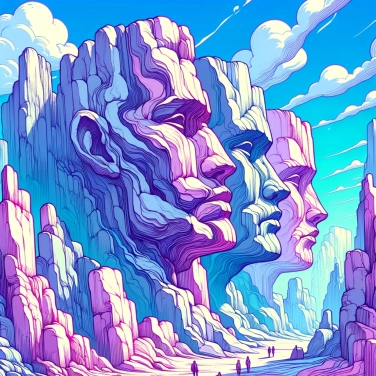Some rock formations resemble human faces due to natural phenomena such as erosion, abrasion, wind and water action, which gradually shape the rock to give it these face-like forms.

Rock formations sometimes take on human-like appearances due to a slow and natural process: erosion. Over the centuries, water, wind, and temperature changes gradually wear away and sculpt the rocks. Some more fragile areas erode quickly, while others that are very solid resist better, giving rise to unusual shapes. This natural work combined with geological cracks and faults, also known as weathering, continually alters the landscape. The result? Rocks that strangely resemble noses, cheeks, or chins!
This astonishing phenomenon is called pareidolia. It is actually a kind of super common brain bug: our brain is so used to quickly recognizing human faces that it believes it sees them everywhere, even where there are none. Scientists think this comes from our evolution: quickly identifying a face allowed our ancestors to quickly detect friends or foes. So, when we look at a cliff or a pile of rocks, our brain automatically tests whether it can spot familiar shapes like two eyes, a nose, and a mouth. As soon as it vaguely finds these clues, bingo, it immediately convinces us that a face is appearing in front of us. So, don't worry, you’re not crazy when you spot a humanoid head in a rock; it's just your brain being overzealous!
Since ancient times, humans have imagined stories associated with their landscapes, and the shapes of rocks are no exception. Do you see a face carved into the mountainside? You immediately project stories of frozen giants, ancient gods, or protective spirits onto it. For example, some indigenous peoples attribute a sacred power to rocks that resemble human forms, believing that they actually embody their ancestors or various deities. This idea of giving a mystical meaning to rock formations reinforces the phenomenon known as pareidolia, as the brain is influenced by culture to more easily recognize these faces. The collective imagination, fueled by myths passed down through generations, unconsciously conditions you to see in these rocks something other than mere pieces of stone.
The Old Man of the Mountain in New Hampshire (USA) was a famous rock formation that perfectly resembled a human face in profile, well-known in the United States before it collapsed in 2003. In Corsica, the site of the Calanques de Piana is renowned for its red rocks sculpted by erosion into strange faces, sometimes visible only from certain angles. In Canada, in Alberta, the Badlands Guardian forms a striking human profile when viewed from the sky, adorned with a traditional Indigenous headdress, spectacular but only fully visible from the air. Another interesting spot is the Sphinx of Bucegi in Romania, where the wind has sculpted the rock into an enigmatic face with features reminiscent of the famous Egyptian sphinx. The Face of Pedra da Gávea in Brazil is also quite intriguing: a huge rock overlooking Rio de Janeiro strikingly resembles a human face, giving rise to all sorts of mystical theories.
The rocks shaped like faces often attract many visitors because they exude a mysterious quality that intrigues tourists. Some of these formations have become true local symbols, with a strong cultural significance. Legends, stories, or even local festivals arise around them. This boosts tourism, encouraging the construction of souvenir shops, hotels, or restaurants, thus enhancing the local economy. These sites sometimes also become sacred places or are imbued with religious or spiritual meaning. People gather there, show respect, and sometimes even venerate them. Essentially, these strange rocks with human faces are more than just a natural curiosity: they have a real cultural, economic, and sometimes even spiritual impact.
The term 'pareidolia' comes from the ancient Greek 'para' meaning 'beside' and 'eidôlon' meaning 'image' or 'form', thus illustrating the natural human tendency to identify a familiar pattern (such as faces) in abstract shapes.
One of the most famous examples of anthropomorphic rocks is the 'Old Man of the Mountain' in New Hampshire, USA. This iconic rock formation unfortunately collapsed in 2003 after thousands of years of erosion.
Some rock formations resembling human faces have been regarded as sacred by many ancient societies, such as the Indigenous peoples of North America, who often saw in these rocks protective spirits or ancestors.
Our brain is so efficient at recognizing faces that we can often instantly perceive a fictitious face in a rock, even with minimal visual cues (two symmetrical dots and a line are often enough to trigger this phenomenon).
Pareidolia is a psychological phenomenon that leads humans to identify familiar shapes, such as faces, in objects that are unrelated to those particular forms. This explains why our brain recognizes faces in rock formations.
Yes, in many ancient cultures, these rock formations were often viewed as having sacred or mythological value, associated with deities or protective guardians of natural places.
Among the most famous are the Sphinx in Egypt, the Old Man of the Mountain in the United States (before its collapse in 2003), the Moai rock on Easter Island in Chile, and the Lion Rock in France.
Indeed, under the ongoing action of erosion, these formations can evolve, lose their anthropomorphic appearance, and even end up disappearing entirely, as was the case with the Old Man of the Mountain.
These particular shapes are mainly due to erosion from water, wind, and thermal variations that slowly sculpt the rock, accidentally creating forms reminiscent of the human face.

No one has answered this quiz yet, be the first!' :-)
Question 1/5